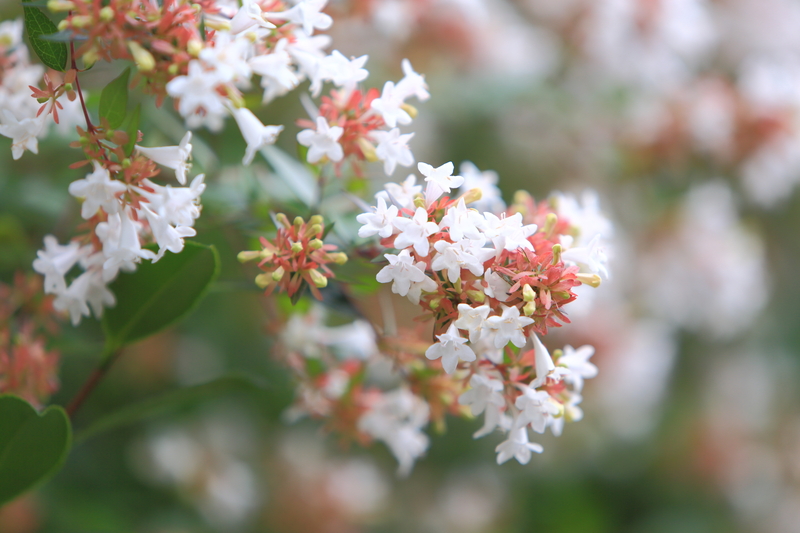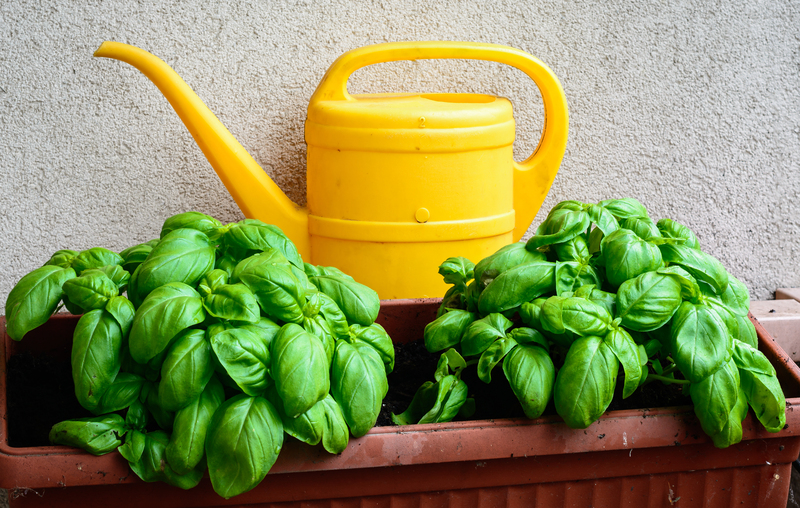Transform Your Space with Vertical Gardening Techniques
Posted on 01/09/2025
Transform Your Space with Vertical Gardening Techniques
Are you seeking innovative ways to revamp your living environment, add fresh greenery, and maximize limited space? Look no further than the transformative power of vertical gardening techniques! With urban spaces shrinking and a rising desire for sustainable living, vertical gardens are revolutionizing both indoor and outdoor landscapes. In this comprehensive guide, we'll uncover how you can utilize various vertical gardening methods to turn even the smallest area into a lush, green sanctuary.

What is Vertical Gardening? Understanding the Basics
Vertical gardening, sometimes referred to as living walls or green walls, involves growing plants upwards rather than outwards. Utilizing walls, trellises, shelving, or special planters, these gardens are perfect for city balconies, patios, or even spacious backyards seeking a modern touch. At its core, vertical gardening is about creatively making use of vertical space to cultivate flowers, herbs, vegetables, and decorative greens.
- Space-saving Solution: Ideal for small homes, apartments, or balconies.
- Air Purification: Plants naturally filter air, contributing to healthier indoor environments.
- Visual Appeal: Adds stylish, modern, and lush vibes to any area.
- Enhanced Privacy: Living walls can act as beautiful, natural privacy screens.
- Increased Biodiversity: Attracts birds, bees, and beneficial insects.
Benefits of Incorporating Vertical Garden Solutions
Implementing vertical gardening techniques brings a host of advantages beyond maximizing floor space. Let's explore some of the key benefits of vertical gardens:
1. Optimized Use of Space
In cities where square footage is a luxury, vertical gardens provide a chance to grow herbs, flowers, and vegetables without compromising valuable ground or patio space. Balcony railings, walls, and fences become thriving hubs for greenery.
2. Improved Air Quality
Whether outside or indoors, dense plantings serve as natural air purifiers. Living walls remove pollutants and release oxygen, improving air quality for residents and visitors alike.
3. Enhanced Aesthetics
A vertical garden wall delivers an immediate visual upgrade. These gardens add texture, color, and a sense of tranquility to otherwise plain or lifeless walls, acting as vibrant decor elements.
4. Greater Insulation and Energy Efficiency
Strategically placed vertical gardens can provide extra insulation, stabilizing temperatures and reducing energy costs. This is particularly effective when installed on exterior building facades.
5. Easier Maintenance
With proper design, vertical gardening systems reduce weed growth and soil-borne pests thanks to contained planters and easily accessible plants.
Popular Vertical Gardening Techniques
There's no one-size-fits-all solution when it comes to creating vertical gardens. From DIY projects to sophisticated living walls, here are the top methods to try:
1. Pocket Planters and Felt Walls
- These involve fabric or felt pockets attached to a frame or wall, each holding soil and individual plants.
- Perfect for growing herbs, succulents, and small flowering plants indoors or outdoors.
- Easy to install and maintain; pockets retain moisture and support healthy root structures.
2. Trellises for Vining Plants
- Use wood, metal, or plastic trellis structures for plants like sweet peas, beans, morning glory, and climbing roses.
- Excellent for transforming a blank wall or balcony railing into a vertical green display.
- Trellises encourage natural growth habits and can be installed in pots or straight in the ground.
3. Vertical Pallet Gardens
- Repurpose discarded wooden pallets by lining them with landscaping fabric and filling with soil.
- Slot herbs, leafy greens, or colorful annuals into the spaces between slats.
- Sustainable and cost-effective option for DIY enthusiasts.
4. Tower Planters and Stacking Containers
- Prefabricated planters designed to stack upwards, forming compact towers for strawberries, lettuce, and small vegetables.
- Great for patios and balconies; easy to rotate for even sunlight.
- Often include built-in watering systems for reduced maintenance.
5. Hanging Basket Arrangements
- Use chains, hooks, or ceiling-mounted systems to suspend baskets filled with trailing plants or flowers.
- Ideal for patios, pergolas, or inside sunrooms with strong natural light.
- Adds depth and layers without sacrificing floor space.
6. Hydroponic Vertical Wall Gardens
- Advanced systems using soilless growing mediums and automated irrigation, perfect for high-tech and space-conscious growers.
- Grow fresh greens, herbs, and even certain fruits year-round.
- Expands food production capabilities indoors, especially in apartments or urban settings.
Step-by-Step Guide: How to Create Your Own Vertical Garden
Ready to get your hands dirty and you're eager to transform your space with vertical gardening techniques? Follow these essential steps for a thriving vertical garden:
Step 1: Assess Your Space
- Identify available wall, fence, or railing space with sufficient sunlight.
- Measure dimensions to determine appropriate garden size and structure.
- Consider weight capacity, especially for balconies or indoor walls.
Step 2: Choose Your Vertical Gardening Method
- Select a technique suited to your space and skill level--for instance, pocket planters for beginners or hydroponics for advanced gardeners.
- Decide if you want a permanent installation or a moveable, seasonal display.
Step 3: Select Suitable Plants
- Light: Choose plants that match your available sunlight (shade-tolerant for dark corners, sun-loving for south-facing walls).
- Water needs: Group plants with similar moisture requirements.
- Size & growth habits: Trailing, compact, or climbing plants suit vertical gardens best.
- Popular choices: Ferns, pothos, philodendrons, succulents, herbs (basil, mint, parsley), strawberries, leafy greens, and flowering vines.
Step 4: Build or Install the Structure
- Assemble your chosen framework, ensuring stability and proper wall fixation.
- Line planters or pockets with suitable materials to retain soil and moisture.
- Arrange containers at even intervals for adequate air circulation.
Step 5: Plant and Arrange Greenery
- Fill containers or pockets with a high-quality potting mix and slow-release fertilizer.
- Gently plant seedlings or cuttings, ensuring healthy root contact with the soil.
- Strategically position trailing or cascading plants at higher levels for visual impact.
Step 6: Watering and Maintenance
- Install a drip irrigation system or hand-water from top to bottom, ensuring even moisture distribution.
- Regularly check for pests, yellowing leaves, or soil dryness.
- Prune, fertilize, and rotate plants to maintain health and appearance.
Pro tip: Always place a waterproof backing or tray behind indoor vertical gardens to protect walls and floors from water damage.
Design Ideas and Creative Arrangements for Vertical Gardens
Vertical gardening is limited only by your imagination! Here are some trendy design ideas to inspire your transformation:
- Living Room Art: Frame a selection of air plants and succulents in a deep photo frame for a stunning wall sculpture.
- Privacy Screens: Densely plant tall grasses or climbing vines on freestanding trellises for natural partitioning.
- Outdoor Fencing: Hang rows of colorful planters along deck or patio fences for bursts of color and texture.
- Edible Walls: Grow culinary herbs and salad greens on kitchen walls for a functional and beautiful edible arrangement.
- Balcony Rail Gardens: Attach trough planters filled with cascading flowers or strawberries for visual appeal and easy harvesting.
- Tiered Bookcase Planters: Repurpose old shelving units or ladders into multi-level plant displays against a window.
Best Plant Choices for Vertical Gardens
Choosing the right plants plays a crucial role in the success of any vertical gardening project. Here's a list of top performers for vibrant, low-maintenance walls:
Ornamental Plants
- Pothos - Resilient, fast-growing vine.
- Ferns - Adds rich texture and thrives in lower light.
- Succulents - Require minimal water, ideal for sunny spots.
- Spider Plant - Tolerates varied light and is easy to care for.
- Philodendron - Attractive, trailing foliage for dramatic displays.
Herbs and Edibles
- Basil, mint, parsley, oregano, thyme, and cilantro.
- Strawberries, lettuce, spinach, and radishes.
- Chili peppers and cherry tomatoes - opt for dwarf or trailing varieties.
Flowering Vines
- Morning glory, clematis, jasmine, and sweet pea.
- Nasturtium - edible flowers and trailing growth.
Remember to consider your local climate and sunlight availability when choosing species, and always match plants to the space's humidity and airflow conditions for best results.

Maintenance Tips for Thriving Vertical Gardens
For your vertical gardening system to truly transform your space in the long term, proactive maintenance is key. Here are essential care guidelines:
- Regular Watering: Check often, as vertical planters can dry out quicker than ground beds.
- Fertilization: Use balanced, slow-release plant food to maintain nutrition--especially in hydroponic systems.
- Pruning: Remove spent leaves and crowded stems to promote airflow and healthy growth.
- Inspection: Watch closely for pests, disease, or mold, particularly in dense arrangements.
- Rotation: Adjust plant positions or swap plants seasonally for even growth and interest.
Install removable panels or modular planters to make maintenance, replanting, and soil replacement simpler as your garden matures.
Transform Your Living or Work Space with Vertical Gardening Techniques Today!
Vertical gardening techniques offer remarkable flexibility, easy installation, and unmatched potential for beautification and sustainability. Whether you're turning a small balcony into a captivating retreat, enhancing your office with a living wall, or growing your own herbs right in your kitchen, the possibilities are endless.
Ready to start transforming your home or outdoor area? Explore creative vertical garden solutions that suit your available space, preferred design, and favorite plants. Share your progress and bring life to every corner with the magic of upward-growing greenery.
Invest in your wellness, your home's aesthetics, and a greener future--the vertical way!



